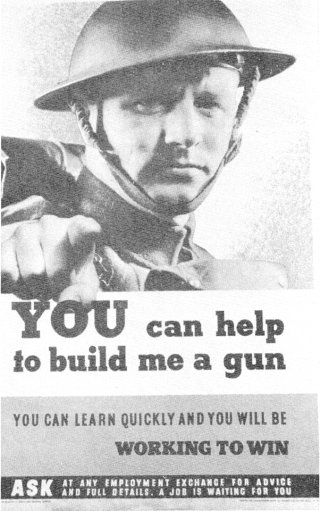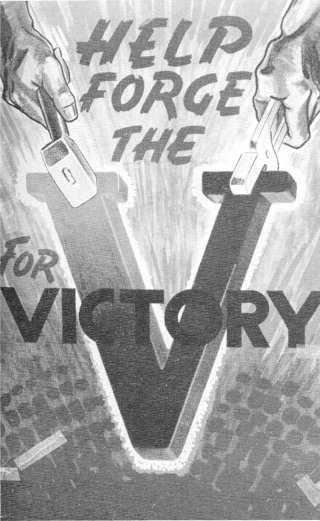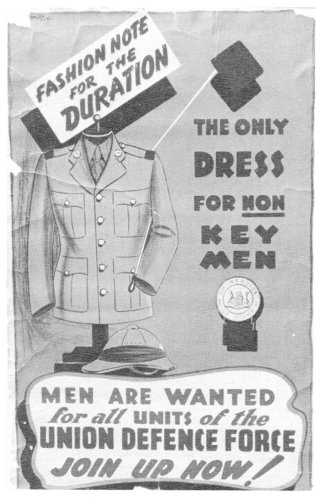

 The South African
The South African
by A Sinclair
The South African National Museum of Military History is the proud owner of approximately 400 posters in its propaganda collection. The bulk of the collection consists of posters published in the Second World War. These have been acquired by means of donations by the SADF, other institutions and individuals.
Military and wartime posters were not generally regarded as great works of art as they were meant to
convey a certain message. They had to be informative, instructive and influence people's perception of the war
in a certain way.(2) The layout had to capture the attention of the audience immediately and hold it long
enough for the audience to be interested in reading all the information.3 Second World War posters were divided
into certain categories, these being:
a) Posters appealing to patriotism.
b) Posters appealing to national security.
c) Posters campaigning for war production.
d) Posters illustrating the military and diplomatic developments of the war.
e) Posters depicting the war atrocities of the enemy.
f) Posters appealing for support for homecoming servicemen.
Due to the fact that South Africa could only rely on volunteers to fill the units of her forces during the war, a massive recruiting drive was instituted in an effort to encourage men to sign up. Posters with slogans such as 'Enlist today, you are wanted at the front' and 'The only dress for non-key men is a Union Defence Force uniform' were placed all around the country.(4) Different services also displayed their own posters. The Artillery units developed slogans such as 'Join the guns'. The idea was to convince the people that they had to do their national duty and defend their country. Patriotic posters thus became the most popular of the wartime posters appealing to the emotions of the nation.(5)

You can help build me a gun
Due to the tremendous industrial needs of the war, as much manpower was required at home in the factories as was required in the forces on the war fronts. Appeals such as 'You can help to build me a gun' and 'Help forge V for victory' were directed at the civilian population. Here the dependence of the soldier on the worker and the parallel created between the soldier on the front and the worker in the factory was stressed.(8)
There were also posters calling on the people to help fund the war effort, especially the national war fund.(9) These posters 'shouted' slogans such as, 'War loan - back the empire with your savings' and '1 pound for 15/6 - if you cannot fight - lend us your money'.

Help forge the V for victory.
War atrocities by the enemy were often depicted on war time posters. Frightening slogans such as, 'I believe - Red Cross or Iron Cross' and 'Nazi war aims - Grab,grab, grab!' appeared stating that the enemy had inhumane tendencies and would not behave decently. These posters were supposed to address the public's hatreds and fears of the enemy.(11)
At the end of the war, posters propagated the assistance of homecoming servicemen in finding employment and settling back into civilian life. 'Thank you soldier, sailor and pilot' were general posters showing gratitude whilst more powerful examples stated, 'He has a claim on you' and 'Help him back to civil life'.

The only dress for non key men is a UDF uniform
1. R Chambers,'Art and propaganda in an age of War: The Role of
Posters' in Militaria, vol 13, no 4, 1983, p 54.
2. J D Cantwell, Images of War, British Posters 1939-1945 (London, HMSO, 1989), p 4.
3. Chambers, 'Art and Propaganda in an age of War', p 54.
4. C Saunders (ed), Illustrated History of South Africa, The Real Story
(Cape Town, Reader's Digest, 1989), pp 347-352.
5. Z Zeman, Selling the War, Art and Propaganda in World War 2
(London, Oribis, 1978), p 31.
6. Illustrated History of South Africa, p 352 Images of War, p 11.
7. Selling the War, p 50.
8. Ibid, p 66.
9. Illustrated History of South Africa, p 352.
10. Selling the War, p 82.
11. Ibid, p 101.
Return to Journal Index OR Society's Home page
South African Military History Society / scribe@samilitaryhistory.org